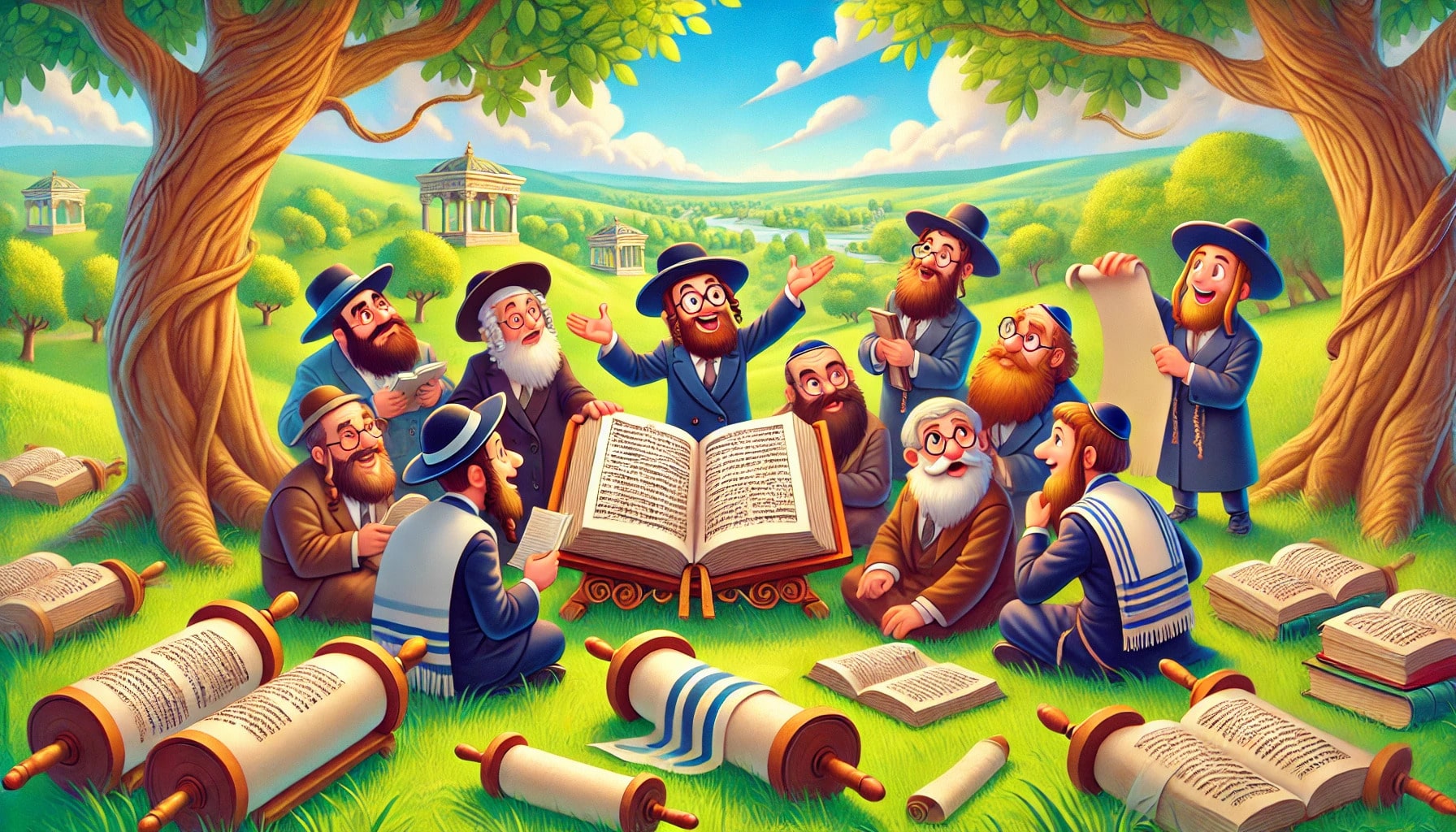| Getting your Trinity Audio player ready... |
Note to Readers: The insights and wisdom in these books are too valuable not to be shared widely. There’s an urgent need for them to be made into audiobooks, expanding their reach and accessibility. If you have the influence or means to make this happen, I encourage you to lend your support. Let’s work together to bring these important words to a broader audience.
Related Study:
Please note that the studies shared on this website are for informational purposes only. Readers are encouraged to critically evaluate the content and not to accept it as absolute or complete without further verification. The views expressed in the studies do not necessarily reflect the opinions of this website.
Midrash, Oral Law, and the Question of Rabbinic Authority by Azzan Yadin-Israel
Rabbi David Zvi Hoffmann, a late-nineteenth century scholar who first taught at and then directed the Berlin Rabbinic Seminary, played a noteworthy role in the study of the legal midrashim—that is, the early rabbinic commentaries on the laws of the Hebrew Bible. His foundational study of legal midrash opens with a discussion of the two forms in which tannaitic legal arguments were transmitted: apodictically (without reference to Scripture) and midrashically. In terms of the tannaitic sources, apodictic arguments predominate in the Mishnah and its companion the Tosefta, though these also contain midrashic passages. The systematic interpretation of the Torah is found in the legal midrashim, which are divided into the school of Rabbi Aqiva and the school of Rabbi Ishmael. This division, first proposed by Hoffmann himself, is based on differences in legal terminology, the names of the sages that appear in each, and interpretive principles. The Mekhilta of Rabbi Ishmael (to Exodus) and the Sifre Numbers make up one group, the Sifra (to Leviticus) and Sifre Deuteronomy make up the other; the former group is associated with Rabbi Ishmael, the latter with Rabbi Aqiva, whose circle also produced the Mishnah.2 The extent to which these works can be traced to a particular sage is a matter of controversy3 and in any case not relevant to my argument. The different interpretive patterns, terminology, and traditions that Hoffmann identified in the legal midrashim are meaningful regardless of their precise provenance.4 As far as the division between apodictic and midrashic legal statements is concerned, it is not surprising that Hoffmann first cites a ruling from the Mishnah, which is not linked to a biblical prooftext, then from the Sifra, the commentary to Leviticus:
2. “Any that has hoofs, with clefts, and that chews its cud from among the quadrupeds—it may you eat” (Lev 11:3): “[It] may you eat,” to include the embryo. Might it be that this is the case even if it emerges only partially? Scripture teaches, saying “it.” (Sifra Shemini pereq 3.1, Weiss 48b)
No law is really binding on the Jew unless it can be shown to have its origin in the Bible. Midrashic form continued to exist, therefore, even after the change to Mishnaic form. It existed in the laws that are found only in the Midreshei Halakhah (that is, those not found in the Mishnah), and it existed concomitantly in the laws that are found in both the Midreshei Halakhah and the Mishnah. For the latter, Midrash served as the ground, the justification, the life support. Indeed, one may legitimately wonder whether the Mishnah would have survived at all were it not for the parallel existence of Midreshei Halakhah.
Though many readers may find this view quite plausible, it entails two critical difficulties. The first is that the Mishnah does present itself in these terms. To the contrary, the Mishnah enunciates a clear, non-scriptural model of authority, most famously in the opening of tractate Avot:
Moshe received the Torah from Sinai and transmitted it to Yehoshua, and Yehoshua to the Elders, and the Elders to the Prophets, and the Prophets transmitted it to the Men of the Great Assembly. (m. Avot 1.1)
More important than any one ideological affirmation is the integration of extra-scriptural tradition into the discursive practices of the Mishnah. This is evident when, for example, shama‘nu and lo’ shama‘nu [“we have heard” and “we have not heard”] refer to having received/not received a legal tradition from one’s master, or in the use of the root q-b-l to refer regularly (but not exclusively8 ) to the reception of legal traditions, as in this example: Nahum the Scribe said: I have received a tradition [mequbbal ᵓani] from Rabbi Measha, who received [qibbel] from his father, who received [qibbel] from the pairs, who received [qibblu] from the prophets as a halakhah given to Moses at Sinai, that if a man sowed his field with two kinds of wheat. (m. Peah 2.6)9 This then is one challenge to Halivni’s position. If the Mishnah were merely an anthology of legal decisions culled from rabbinic midrash, it would not need to anchor its teachings in an extra-scriptural model of rabbinic authority. It would not, in other words, present the rabbis as heirs to what would later come to be known as the Oral Torah, often identified as constitutive of rabbinic Judaism itself.10 The second difficulty involves the Sifra’s interpretation of the phrase “it may you eat” in Leviticus 11:3, which draws the permission to eat an embryo from the phrase “may you eat” and the prohibition on eating a partially emerged embryo from the pronoun “it.” Let us begin with the plain sense of the verse—namely, the determination that animals with cleft hooves that chew their cud are edible: “Any that has hoofs, with clefts, and that chews its cud from among the quadrupeds—it may you eat.” Though the Sifra does not make this claim explicitly, the starting point of its interpretation is the arguably marked syntax of the verse, which first describes the animal and then concludes with “it may you eat” [תאכלו אתה[. The Sifra does not state explicitly what it finds unusual about the phrase, only that it is a warrant to midrashically augment the verse. The interpretive logic of this move is familiar from early rabbinic midrash: an anomaly in the verse elicits a rabbinic response. What is puzzling is the legal content that the Sifra adduces: “‘[It] may you eat,’ to include the embryo”—that is, the phrase indicates that it is permitted to consume the embryo of the animal being slaughtered. But the Sifra does not link the embryo to the language of Leviticus 11:3, or of any other verse for that matter, so there is no direct scriptural justification for this specific conclusion. Why does the phrase “it may you eat” sanction the inclusion of the embryo rather than any other element not specified in the verse? This is not clear. The disengagement from Scripture is more pronounced in the argument’s next step, where the pronoun “it” [אתה [anchors the ruling that if the embryo has partially emerged from its mother’s body, it is prohibited. Again, the Sifra does not provide guidance as to what it finds remarkable about the pronoun. Perhaps the issue is that the meaning of the verse remains intact without the pronoun, or maybe it is the fact that direct object pronouns can be expressed in Hebrew either as an independent word [תאכלו אתה [or as a pronominal suffix to the verb [תאכלוה[. Or perhaps it is another issue; the Sifra is silent on the question. Irrespective, the real difficulty is the legal decision the pronoun is made to bear regarding the partially birthed embryo. For on what grounds can the phrase “it may you eat” be divided into its constitutive elements, “it” on one side and “may you eat” on the other, each made the basis for a different type of legal argument: “may you eat” expands the scope of the biblical verse to include the embryo, while “it” qualifies the expansion by excluding the partially emerged embryo? Returning to Halivni’s statement, it is not clear to what extent we can say that the law in question, even when the Sifra presents it as a midrash to Leviticus 11:3, is “shown to have its origin in the Bible.”
Rather than clarify the question of the dual presentation of rabbinic law—midrashic and extra-scriptural—the discussion to this point has complicated it. If Mishnah states that it is permitted to consume an embryo except in the case that it is partially emerged, why does the Sifra anchor the same rulings in such a problematic and perplexing discussion of Leviticus 11:3? A possible clue involves the fierce debate within late antique Jewish sources regarding the relationship between scriptural interpretation and received tradition. I state at the outset that I know of no sources that reject the authority of the Torah. The dispute hinges on whether Scripture is the sole source of Jewish legal authority or whether an extra-scriptural chain of tradition represents a second, independent source of authority. In Book 13 of the Antiquities of the Jews, Josephus refers briefly to one of the differences between the Pharisees and the Sadducees:
One group unequivocally situated on the sola scriptura side is the Qumran community, whose writings reflect a single-minded commitment to scriptural authority. Part of this commitment is evident in the way Torah study is legislated into the very fabric of the community:
Rabbinic law recognizes a category known as “tent impurity” or “canopy impurity,” which occurs when there is an overhang directly above an impure object that “captures” the object’s impurity and transmits it to anyone within the enclosure. The Mishnah begins with an anonymous statement regarding the minimum size for a movable object to convey such impurity. Rabbi Tarfon disputes the legitimacy of this tradition, arguing that it was perverted—misremembered or misunderstood—in the course of its transmission. Rather, the correct ruling refers to the ox-goad, but only in assessing its breadth, insofar as a herdsman who carries one over his shoulder creates a canopy of sorts and is thus susceptible to the impurity of a tomb by which he passes. There are, then, two competing oral traditions that refer to the ox-goad, and Rabbi Tarfon believes his is correct, while the anonymous statement is a corruption (“the hearer heard wrong”). Faced with this apparent deadlock, Rabbi Akiva seeks to “amend [this halakhah] so that the words of the sages shall be sustained,” by proposing a third legal statement that incorporates elements of both the anonymous ruling and Rabbi Tarfon’s tradition—another indication of the status of received traditions in some tannaitic sources.
Perhaps the most telling statement concerning the topic under discussion is from Rabbi Yehoshua, one of Rabbi Akiva’s rabbinic masters. Leviticus 11:33 states that everything in an earthenware vessel becomes impure if a dead animal falls into it, but Rabbi Akiva midrashically interprets “shall be impure” as “shall transmit impurity.” According to Leviticus, if a dead animal falls into a vessel, the vessel becomes impure with first-level impurity, and a loaf in the vessel contracts second-level impurity. Rabbi Akiva interprets Leviticus 11:33 as indicating that the second-level impure loaf then transmits third-level impurity if it comes in contact with another loaf. Upon hearing this interpretation, Rabbi Yehoshua said: “Who will uncover the dust from your eyes, Rabbi Yohanan ben Zakkai, for you used to say that a future generation will declare the third-level loaf pure since it is not scriptural [she-lo’ min ha-torah]—but your disciple Rabbi Akiva adduced a scriptural prooftext for its impurity, as it is written ‘everything inside it shall be impure.’”













